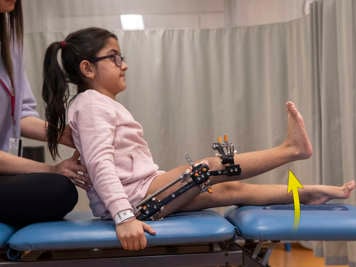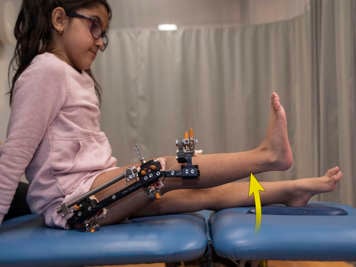Following surgery, your child will experience some edema (swelling) and stiffness. Regular exercises will help your child minimize swelling and maintain range of motion and muscle strength.
Managing edema
It is important to keep the leg elevated above the heart when resting and to perform regular ankle pumps and circles.
Ankle pump and circles
Starting position: Sitting on a bed or a chair with leg extended straight
- Move the ankle to bring the toes and foot towards the face.
- Move the foot back down like it is pushing on a gas pedal.
- Move the ankle in circles in both directions. It might help to imagine drawing a circle with the big toe.
Do _____ pumps and circles (each direction) every hour or if your child is sitting for a long time.
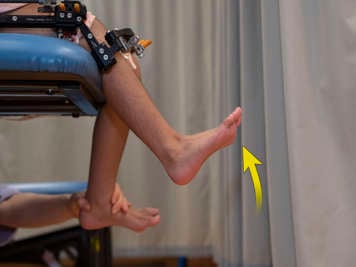
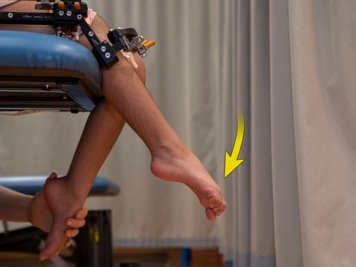
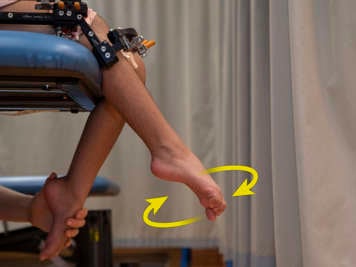
Range of motion exercises
Range of motion exercises help maintain movement in your child’s joints throughout your child’s leg lengthening process. It is very important to do them to prevent joint stiffness and any related complications.
Notes about the exercises
- Your child may not need to do all the exercises shown here. Your child’s physiotherapist will explain which exercises your child should do and how to modify them if needed.
- Some exercises require you to handle your child’s leg to further a stretch or support the weight of their frame. Depending on the location of your child’s frame and pin sites, your handling may vary a little from the descriptions below. Your child’s physiotherapist will help you with this.
- As a general rule, try to place your hands as close as possible to the joint you are stretching to avoid added stress through the bone.
- Your child should do the recommended exercises three times a day or as often as instructed by the physiotherapist.
Ankle dorsiflexion (DF) while sitting
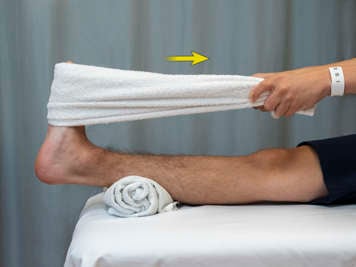
Starting position: Sitting on a bed with leg extended straight
Warm-up: Move your ankle up and down slowly 10 times to warm up the muscles and make the stretch more comfortable
- Wrap a towel or thick band around the middle of the foot and hold one end in each hand.
- Keeping the knee as straight as possible, have your child slowly pull their foot towards their face using their own muscles.
- Use the towel to bring the foot further into a stretch. Your child should feel this in the back of their calf.
- Hold for ______ seconds.
Do exercise _____ times. Repeat _____ times a day.
Ankle DF while sitting (assisted)
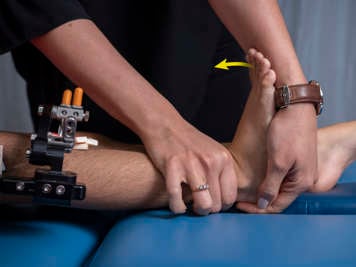
Starting position: Sitting on a bed with leg extended straight
- Have your child bring their toes and ankle towards their face as much as they can on their own, without raising their leg off the bed.
- You (the parent or caregiver) can gently further the stretch, making sure the leg remains straight. Your child should feel this in the back of their calf.
- Hold for ______ seconds.
Do exercise _____ times. Repeat _____ times a day.
Knee flexion and extension (active assisted)
Starting position: Lying down on a bed or other smooth surface (to allow the heel to slide)
Warm-up: Slowly bend and straighten the knee 10 times as much as possible in each direction
- For flexion, bend the knee and slowly slide the heel up towards the bum, as far as it can go. If the heel cannot touch the bed because of the frame, you can support your child’s leg and help them move it to make sure that they have a full range of motion.
- When your child feels a stretch over the front of their thigh, hold the position for five seconds.
- For extension, slowly move the heel back down the bed until the leg is straight again.
Do ____ times. Repeat ____ times a day.
*Note: Some children may require the adult assisting them to perform most of the movement. This will be determined by your child’s physiotherapist.
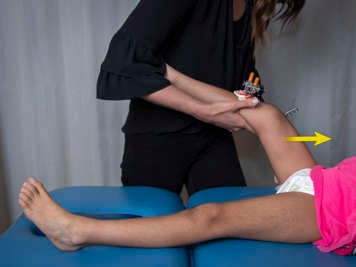
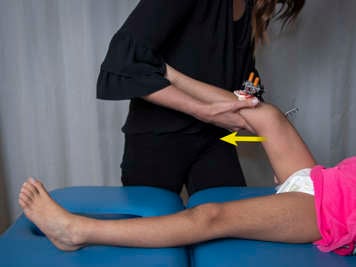
Knee flexion (assisted)
Starting position: Sitting at the edge of a chair or bed
- Straighten the leg as much as possible.
- Slowly bend the knee. You should let your child bend their knee as much as they can by themselves first. Use one hand to keep the upper leg still and the other hand to support the knee.
- When your child can no longer bend their knee themselves, place your hand just below the knee to gently continue bending the knee until your child feels a stretch in the font of their thigh or until the frame stops them from bending any further.
- Hold for ___ seconds.
Do exercise ___ times, making sure the leg straightens each time. Repeat ___ times a day.
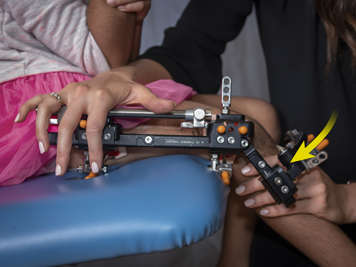
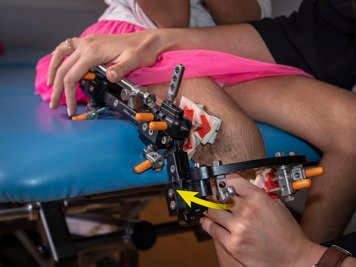
Prone lying
Starting position: Lying on the stomach on a bed, with knees and lower leg off the edge of the bed
- Have your child lie like this for 15 to 20 minutes, making sure that the front of the hips stay flat on the bed. This keeps the pelvis level.
- If the frame is too heavy, you can support your child’s lower leg, or place a stool under it, making sure the knee can stay completely straight. The stool should be lower than the bed to ensure there is no bend in the knee.
- Perform this stretch once daily.
For this stretch, the position of the opposite leg may vary, as shown in the photos. The physiotherapist will decide if it should be straight (see left photo) or bent (see right photo) and will help keep the opposite leg in position.
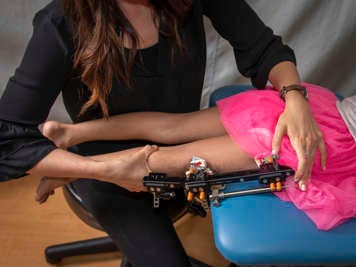
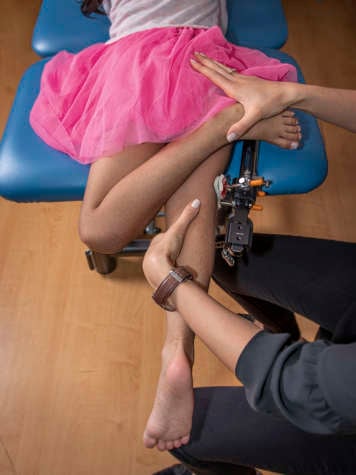
Prone knee bend
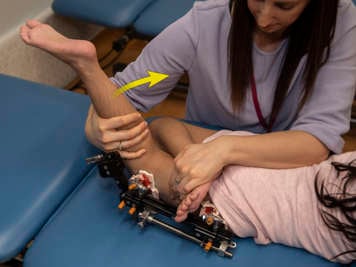
Starting position: Lying on the stomach with the hips level
- Support the leg you are stretching by placing one hand just below the knee as shown, and the other hand on the thigh.
- Slowly bend the child’s knee, making sure the lower leg stays in line with the top of the leg and torso.
- Keep bending the knee until your child feels a stretch over the front of the thigh.
- Hold for _____ seconds.
Do exercise _____ times. Repeat _____ times a day.
Hip flexor stretch
Starting position: Lying down, with the lower back flat on the bed and the legs hanging over the edge. The bed should be high enough that the feet do not touch the floor.
- Have your child slowly bend their knee without a frame up to their chest and hold it. To bend the knee, their hands should be just below the knee joint as shown in the picture below. The leg with the frame should have the knee bent over the edge of the bed.
- If your child feels a stretch through the front of their hips, this may be enough of a stretch. If your child does not feel a stretch, have them slowly pull the knee without a frame closer to their chest until a stretch is felt.
Do exercise _____ times. Repeat _____ times a day.
*Note: It is important that the thigh stays lined up with the torso throughout the stretch. Do not let your child’s leg drift out to the side, as this minimizes the effectiveness of the stretch.
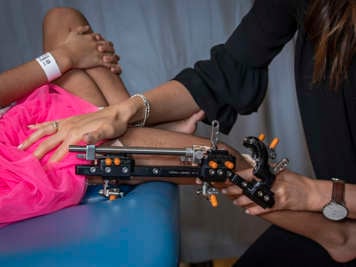
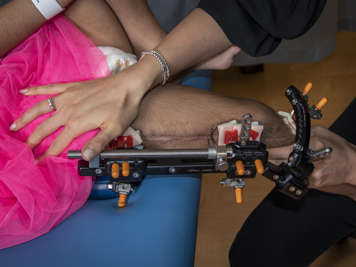
Hamstring stretch
Starting position: Lying on the back
- Support your child’s leg just above the knee and at the hip, with their ankle resting on your shoulder. Depending on how flexible your child’s hamstrings are, you may not be able to raise their leg off the bed as shown below. Your child’s physiotherapist will assist you with this. Your child should feel a stretch through the back of their thigh and knee.
- Hold for ____ seconds.
Do exercise ___ times. Repeat ____ times a day.
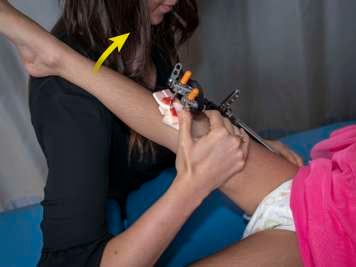
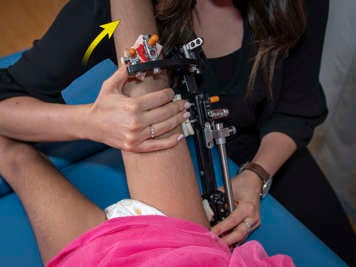
Hip internal and external rotation
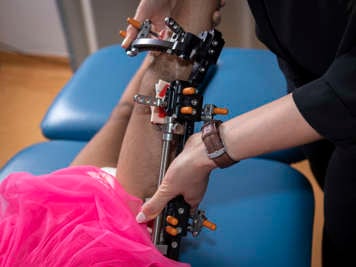
Starting position: Lying on the back with the legs straight
- Support your child’s leg just below the knee and at the thigh.
- For internal rotation, slowly rotate the leg inward. The toes and kneecap should be rolling inward with the leg as you rotate. Your child should feel a small stretch over the outside of their thigh.
- For external rotation, slowly rotate the leg outward. The toes and kneecap should be rolling outward with the leg as you rotate. Your child should feel a stretch through the inside of their thigh.
Do exercise ____ times. Repeat ____ times a day.
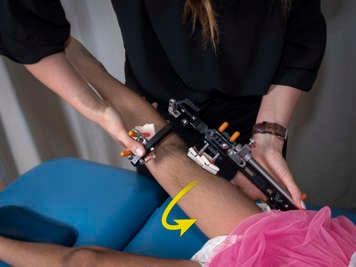
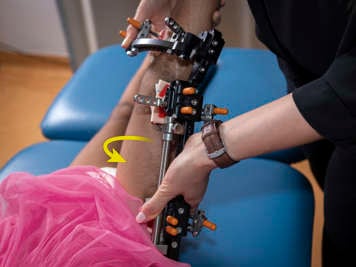

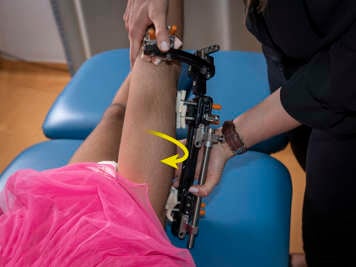
Hip abduction and adduction (windshield wipers)
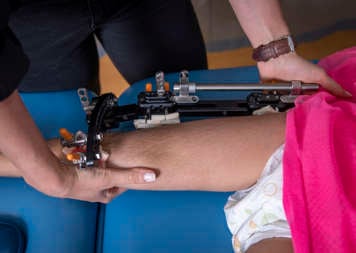
Starting position: Lying on the back with legs straight and toes/knees pointed towards the ceiling. The leg without a frame should be moved to the side or hooked over the side of the bed as shown in the pictures.
- For hip abduction, slowly bring the entire leg (keeping the knee straight) out to the side as much as possible. You should be supporting the childs leg just above or below the knee and at their hip as shown in the pictures. Continue the movement until a stretch is felt along the inside of the thigh.
- Hold for five seconds.
- For hip adduction, slowly bring the leg back to midline (the starting position), and then past midline until a stretch is felt through the outside of the thigh.
- Hold for five seconds.
Do ____ times. Repeat ____ times a day.
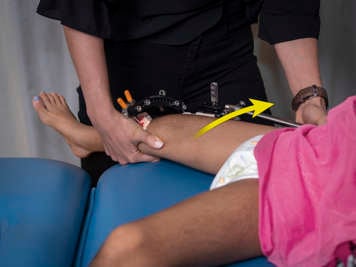
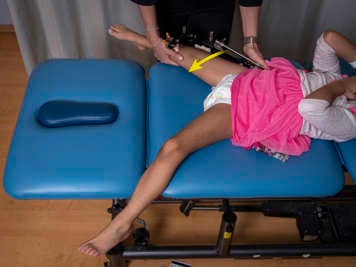
Strengthening exercises
Strengthening exercises help maintain the strength of your child’s muscles throughout the leg lengthening process. It is important to do them to maintain your child’s mobility.
Isometric quadriceps (static contractions)
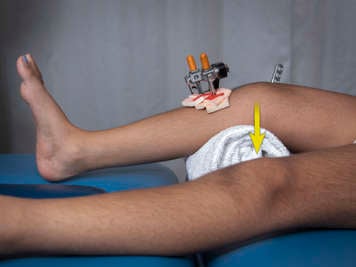
Starting position: Lying down on a bed with a small roll or towel under a slightly bent knee
- Have your child tighten their thigh muscles and push their kneecap down into the towel. They should make the knee as straight as they can. Make sure the kneecap and toes point straight up towards the ceiling throughout the exercise.
- Hold for 3-5 seconds.
- Relax.
Do exercise ____ times. Repeat ____ times a day.
Quadriceps setting over roll
Starting position: Lying down on a bed, knee slightly bent over a rolled-up towel
- Have your child tighten their thigh muscles and push their knee down into the roll.
- Lift the lower leg and foot up off the bed. Keep the knee on the roll and make sure the kneecap and toes point straight up towards the ceiling throughout the exercise.
- Try to hold the leg up for 3-5 seconds.
- Slowly lower the leg back down.
Do exercise _____ times. Repeat ____ times a day.

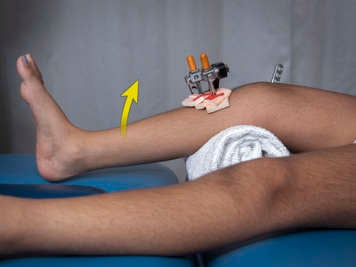
Straight leg raise
Starting position: Lying on the back or sitting up with the back supported
- Have your child tighten their thigh and glute muscles and keep their knee straight.
- Slowly lift the leg straight off the bed, keeping the knee straight.
- Hold this position for 3-5 seconds.
- Slowly lower the leg back down to the bed.
Do exercise _____ times. Repeat _____ times a day.
